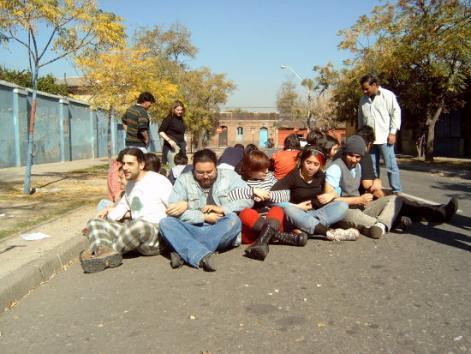We don't say that you need nonviolence training before you go out on the street and hold up a placard or give out a leaflet. Not in most countries anyway. However, the whole process we refer to as nonviolence training—analysing issues, envisioning alternatives, drawing up demands, developing campaign strategy, planning actions, preparing actions, evaluating actions or campaigns—can increase the impact your group has on others, help you to function better in action and cope better with the risks and problems it poses, and expand your action horizons. Basically, nonviolence training helps to create a safe space to test out and develop new ideas or to analyse and evaluate experiences.
Nonviolence training can help participants form a common understanding of the use of nonviolence in campaigns and actions. It is a participatory educational experience where we can learn new skills and unlearn destructive and oppressive behaviours society has taught us. Nonviolence training can strengthen a group, developing a community bond while people learn to work better together and clarify their intentions. Nonviolence training can help us understand and develop the power of nonviolence. It gives an opportunity to share concerns, fears, and feelings and to discuss the role of oppression in our society and our groups. Individually, training helps build self-confidence and clarify our personal interactions. The goal of nonviolence training is empowering the participants to engage more effectively in collective action. The process includes various exercises and training methods, some of which are included in this Handbook in Section Seven.
Nonviolence training can prepare people for participation in nonviolent direct action, teach strategy development techniques and the skills needed to engage in the strategy, and work on group process and issues of oppression. Nonviolence trainings are often used to prepare people for specific actions, to learn about the scenario, to develop a plan and practice it, to understand the legal issues, and more. They are an opportunity for a group to build solidarity and to develop affinity groups. Through role playing (see 'Role Playing' Exercise), people can learn what they might expect from police, officials, other people in the action, and themselves. It can help people decide if they are prepared to participate in the action.
Nonviolence trainings can range from several hours to several months, depending on factors such as the campaign's needs and timeline, the goals for the training, and the experience and availability of the participants and trainers. (See 'Tasks and Tools for Organising and Facilitating Trainings', for more on planning nonviolence trainings.)
BOX or Side panel: “My first training experience was for the 15th of May action in Israel in 2003. I was a Chilean conscientious objector who had been involved in campaigning against militarism for a number of years. The training was truly empowering to me, and I went back home with the urge to share what I had learned and that if we wanted to be successful in our actions, training ourselves was going to be essential. The next actions we did were not just with all the group standing in front of the military building but with a higher level of risk because of the higher level of confidence we had, because we were prepare and trained for it.' Javier Gárate
Role of Trainers
A nonviolence trainer is someone who can facilitate a group through a learning process. A trainer must be knowledgeable regarding the topics of the training, but should not be a know-it-all. A trainer's goal is to guide the participants to develop their own ideas, not to tell people what to think and do. We realise that not all groups and communities who want nonviolence training have local trainers. But when people understand what skills are needed to conduct a training, they may realise they have already developed some of those skills and used them in different contexts. You can create a training team of co-facilitators who together can bring their skills and experience. If possible, the training team should reflect the participants, consisting of women and men and people of various ages and ethnic backgrounds.
Trainers need:
* Good group process skills and an awareness of group dynamics. It is the role of the trainer to make sure everyone participates and feels able to share insights and experiences. * An understanding of nonviolent actions and campaigns. If no one has experience, the trainer needs to use case studies and exercises to help the group learn.
To learn how and when to use the right exercises, being sensitive to the needs and styles of groups.
Potential Topics for Nonviolence Training
* History and philosophy of nonviolence and practice of nonviolent action. * Overcoming oppression, ethnic/racial, and gender dynamics (See Section Two and Resources in Section Ten). * Campaign strategy development (see Section Three). * Consensus decision-making and quick decision-making (see 'Working in Groups', and 'Decision-Making' Exercise). * What an affinity group is and roles within the group (see 'Affinity Groups' and 'Roles In, Before, and After an Action). * Skills such as legal and media work (see 'Legal Support', and 'The Role of Media').

Comments
There are no comments on this article. Have you got something related to this topic, you'd like to say? Please feel free to be the first person to make a comment.
Add new comment